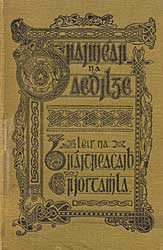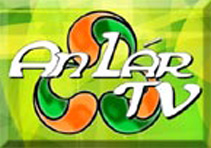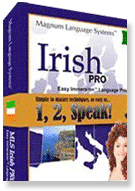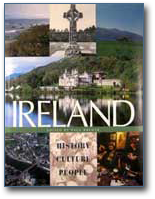The Irish Gaels
The Irish Gaels are an ethnic linguistic group which originated in Ireland
and then spread to Scotland and the Isle of Man. They are three different forms
of the Goidelic, or Gaelic languages; Irish Gaelic, Scottish Gaelic and Manx
Gaelic. The Gaelic languages are a branch of the Insular Celtic languages of
Great Britain and Ireland. The other branch of Insular Celtic is Brythonic
which are the Gaelic languages of Breton, Cornish and Welsh.
Many people who do not speak fluent Gaelic consider themselves to be Gaels, in a broader sense, because of their ancestry and heritage.The word in English was adopted in 1810 from Scottish Gaelic Gaidheal, compared to Irish Gael/Gaedheal and Old Irish Goídel, to designate a Highlander. Gael or Goídel was first used as a collective term to describe people from Ireland and it is thought to have come from Old Welsh Guoidel 'raider', which in modern Welsh, Gwyddel means 'Irish person'.
According to modern definitions:
Gaels: the ethno-linguistic group
Gaelic: of or relating to the Gaels
Goidels: an alternative term sometimes used to describe the Gaels
Goidelic: of or relating to the Goidels or Gaels, particularly their language, and is also the name for Iona University.
Mythological origins of the Gaels began during the beginning of the Christian era, at which time Gaelic people were mostly restricted to Ireland. They considered themselves to be descendants of the Milesians, the sons of Míl Espáine, of the Iberian Peninsula. This is believed in the Gaelic cultures of Ireland and Scotland up to the present day. Many, if not most, clan leaders in either country claim descent from their predecessor back to famous historical kings, and as far back into prehistory as Cormac Cas.
The book Lebor Gabála Érenn, or Irish Texts Society, by editor R.A.S. Macalister, which catalogues the path of the Gaels' ancestors in a way that, while mostly mythical, may be an embellished version of actual historical facts.
It is not known exactly when speakers of the Goidelic, or Q-Celtic, language reached Ireland, or how they came to be the dominant culture. It is possible that Q-Celtic developed entirely in Ireland from a previous dialect. Some believe that Goidelic replaced some pre-existing Brythonic, or P-Celtic languages, but it is not known if this represents one population displacing others, an invasion resulting in a new ruling caste, or simply the spread of the new Lingua Franca.
Lingua Franca is a trade language, used by numerous language communities around the Mediterranean, to communicate with others whose language they did not speak. Before and during the age of the Roman Empire, there was a great deal of movement, interaction and competition among the peoples who, though of neither ethnicity, fell in with the Celtic and Germanic culture.
Estimates of the arrival of Gaelic in Ireland vary widely from the introduction of agriculture, circa 4000 B.C. to around the first few centuries B.C. The language now known as Old Irish, ancestral to modern Irish, Scots Gaelic and Manx, only began to be properly recorded with the Christianization of Ireland in about the 5th Century A.D.
It is believed that Ireland's pre-Christian culture disparaged written language. However, Old Irish, or more correctly, its precursor, Primitive Irish, does appear in a specialized written form, using a unique script known as Ogham. This is represented by notches for vowels and lines for consonants and is known to us now almost only in the form of memorial inscriptions or short epitaphs on pillar-like stone monuments.
Ogham stones are found both throughout Ireland and where Gaelic invaders settled across post-Roman Britain. It is thought to have been in use as early as 400 A.D. They frequently encode nothing more than a name and it is thought they may possibly represent territorial claims.
Starting sometime around the 5th century, Gaelic language and culture spread from Ireland to the southwest coast of modern Scotland, where it may have already existed since Roman times. However, there is disputed archaeological evidence to support the generally accepted tale of migration while there is also some to suggest that there was none. Evidence also points to the population of the area, which is modern day Argyll, being constant during the time of the alleged invasion of Scotland. This area was known as Dál Riata, from where the Gaels soon spread out to most of the rest of the country.
The dominance of the Gaelic language in this area eventually led to the Latin name for Gaelic speaking peoples, Scoti. It was also applied to the state founded by the Gaels - Scotland. Since that time, the Gaelic language rose and, in the past three centuries, greatly diminished in most of Ireland and Scotland. The most culturally and linguistically Gaelic regions are in the north west of Scotland, the west of Ireland and Cape Breton Island in Nova Scotia, where the descendants of the Scottish Highlanders were transplanted.
The Isle of Man also came under massive Gaelic influence in its history. The last native speaker of Manx died in the 1970's, though use of the Manx language never fully ended. There is now a resurgent language movement and Manx is once again taught in all schools as a second language and in some as a first language.
A large part of the island's cultural heritage is Gaelic.The two major Gaelic nations in the modern era are Scotland and Ireland. Communities where the language is still spoken natively are restricted largely to the west coast of each country and, especially, the Hebrides in Scotland. However, large proportions of Gaelic speakers also live in the cities of Glasgow and Edinburgh, in Scotland, as well as Galway, Cork and Dublin, in Ireland.
There are between 500 to 1,000 Canadian Gaels but they are generally of a very advanced age and concentrated in Nova Scotia, Cape Breton Island and Newfoundland. According to the 2000 U.S. census, there are over 25,000 speakers of Irish in the United States with the majority found in large Irish-American communities such as Boston, New York City and Chicago.
Many people who do not speak fluent Gaelic consider themselves to be Gaels, in a broader sense, because of their ancestry and heritage.The word in English was adopted in 1810 from Scottish Gaelic Gaidheal, compared to Irish Gael/Gaedheal and Old Irish Goídel, to designate a Highlander. Gael or Goídel was first used as a collective term to describe people from Ireland and it is thought to have come from Old Welsh Guoidel 'raider', which in modern Welsh, Gwyddel means 'Irish person'.
According to modern definitions:
Gaels: the ethno-linguistic group
Gaelic: of or relating to the Gaels
Goidels: an alternative term sometimes used to describe the Gaels
Goidelic: of or relating to the Goidels or Gaels, particularly their language, and is also the name for Iona University.
|
|
Mythological origins of the Gaels began during the beginning of the Christian era, at which time Gaelic people were mostly restricted to Ireland. They considered themselves to be descendants of the Milesians, the sons of Míl Espáine, of the Iberian Peninsula. This is believed in the Gaelic cultures of Ireland and Scotland up to the present day. Many, if not most, clan leaders in either country claim descent from their predecessor back to famous historical kings, and as far back into prehistory as Cormac Cas.
The book Lebor Gabála Érenn, or Irish Texts Society, by editor R.A.S. Macalister, which catalogues the path of the Gaels' ancestors in a way that, while mostly mythical, may be an embellished version of actual historical facts.
It is not known exactly when speakers of the Goidelic, or Q-Celtic, language reached Ireland, or how they came to be the dominant culture. It is possible that Q-Celtic developed entirely in Ireland from a previous dialect. Some believe that Goidelic replaced some pre-existing Brythonic, or P-Celtic languages, but it is not known if this represents one population displacing others, an invasion resulting in a new ruling caste, or simply the spread of the new Lingua Franca.
Lingua Franca is a trade language, used by numerous language communities around the Mediterranean, to communicate with others whose language they did not speak. Before and during the age of the Roman Empire, there was a great deal of movement, interaction and competition among the peoples who, though of neither ethnicity, fell in with the Celtic and Germanic culture.
Estimates of the arrival of Gaelic in Ireland vary widely from the introduction of agriculture, circa 4000 B.C. to around the first few centuries B.C. The language now known as Old Irish, ancestral to modern Irish, Scots Gaelic and Manx, only began to be properly recorded with the Christianization of Ireland in about the 5th Century A.D.
It is believed that Ireland's pre-Christian culture disparaged written language. However, Old Irish, or more correctly, its precursor, Primitive Irish, does appear in a specialized written form, using a unique script known as Ogham. This is represented by notches for vowels and lines for consonants and is known to us now almost only in the form of memorial inscriptions or short epitaphs on pillar-like stone monuments.
Ogham stones are found both throughout Ireland and where Gaelic invaders settled across post-Roman Britain. It is thought to have been in use as early as 400 A.D. They frequently encode nothing more than a name and it is thought they may possibly represent territorial claims.
Starting sometime around the 5th century, Gaelic language and culture spread from Ireland to the southwest coast of modern Scotland, where it may have already existed since Roman times. However, there is disputed archaeological evidence to support the generally accepted tale of migration while there is also some to suggest that there was none. Evidence also points to the population of the area, which is modern day Argyll, being constant during the time of the alleged invasion of Scotland. This area was known as Dál Riata, from where the Gaels soon spread out to most of the rest of the country.
The dominance of the Gaelic language in this area eventually led to the Latin name for Gaelic speaking peoples, Scoti. It was also applied to the state founded by the Gaels - Scotland. Since that time, the Gaelic language rose and, in the past three centuries, greatly diminished in most of Ireland and Scotland. The most culturally and linguistically Gaelic regions are in the north west of Scotland, the west of Ireland and Cape Breton Island in Nova Scotia, where the descendants of the Scottish Highlanders were transplanted.
The Isle of Man also came under massive Gaelic influence in its history. The last native speaker of Manx died in the 1970's, though use of the Manx language never fully ended. There is now a resurgent language movement and Manx is once again taught in all schools as a second language and in some as a first language.
A large part of the island's cultural heritage is Gaelic.The two major Gaelic nations in the modern era are Scotland and Ireland. Communities where the language is still spoken natively are restricted largely to the west coast of each country and, especially, the Hebrides in Scotland. However, large proportions of Gaelic speakers also live in the cities of Glasgow and Edinburgh, in Scotland, as well as Galway, Cork and Dublin, in Ireland.
There are between 500 to 1,000 Canadian Gaels but they are generally of a very advanced age and concentrated in Nova Scotia, Cape Breton Island and Newfoundland. According to the 2000 U.S. census, there are over 25,000 speakers of Irish in the United States with the majority found in large Irish-American communities such as Boston, New York City and Chicago.
Disclaimer: LittleShamrocks.com is an affiliate website that receives commissions from sales of the products listed. We have purchased and sampled many, but not all, of the products on these pages.
© Copyright LittleShamrocks.com. All Rights Reserved.









